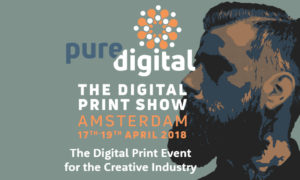Print vult het gat op
 De organisator (Frazer Chesterman) van de beurs Pure Digital, die volgend jaar april in Amsterdam gehouden wordt, heeft een interessante visie op de functie van Print. In zijn column stelt hij dat mensen overladen worden met informatie, en dat Print daarom een steeds belangrijkere rol kan gaan spelen.
De organisator (Frazer Chesterman) van de beurs Pure Digital, die volgend jaar april in Amsterdam gehouden wordt, heeft een interessante visie op de functie van Print. In zijn column stelt hij dat mensen overladen worden met informatie, en dat Print daarom een steeds belangrijkere rol kan gaan spelen.
Lees hier zijn column:
It wasn’t so long ago that your TV only had 4 or 5 channels and your phone was for making calls with. However, now we are constantly bombarded by an information overload. How can print survive in this crazy new environment?
Put yourself in the shoes of a consumer right now. Just for a second. Imagine that it’s the 1950s. You consume as much content as you can. You likely frequent your local library. Perhaps you listen to the radio and watch the nightly news on TV. Maybe you also subscribe to, and read the entire, daily newspaper. Maybe your household receives a few magazines every month. That’s about it. There really isn’t a big difference between the information you know is available and the information you can consume.
Now, fast forward to 2017. You live in a 200-channel television universe, there are multiple daily metropolitan newspapers, apps, mobile phones, Instagram, Facebook, Google and the technology is exploding. Suddenly, there is far more content created than you can consume.
So, what do I think has happened? I can certainly consume more content than I could two decades ago, but no matter how much content is available, I can’t consume much more. And relative to the sheer volume of content available to me, I’m actually consuming a smaller percentage every day.
Now, put on your Marketer Hat or your Content Creator Hat again and take a look at the Information Overload chart above. The bottom line represents the consumer’s ability to consume more content. Yes, it’s gone up – but only ever-so-slightly.
Now look at the top line (the information available). It’s sky-rocketing and shows no signs of slowing down. The consumer stands no chance of consuming much more of that wonderful content you’re creating than they could yesterday or they will tomorrow.

The gap between the two is the perceived opportunity gap. Marketers are trying to squeeze information about their products in the gap.
The biggest opportunity today is to be part of the information that people can consume and not in the area of overload – the Actual opportunity GAP.
I believe there is tremendous opportunity for Print to fit in the gap. This is all about creating quality content over quantity.

So think about how to use all the digital content that is being created to elevate content to print – elevate shortlived digital successes to high quality printed products, extending the digital life span and reap the rewards for four to six weeks.
It also means we need to define our roles in this ever-growing world of content creation. In my opinion, this is why we see a huge interest in content curation over content creation. It represents the desire of the consumer to filter out the noise and get straight to relevant, high-quality content, given the limitations on their ability to consume.
So, where’s the opportunity? Content curation is certainly one avenue to pursue. Anytime you can help your audience find the best content, more efficiently, more often, you’re building trust.
However, in order to be successful at this, your brand must be perceived as a completely objective brand in the marketplace. Otherwise, your consumer has to find multiple curators and still consume more content to ensure they get the ‘whole picture.’ The content curation model is really designed to help consumers more efficiently find relevant content, not necessarily the bestcontent.
The real opportunity here, in my opinion, is to create – and curate – the best content focused on one specific area frequently enough that you become the one brand that consumers look to for this information. It’s the opportunity of proving your brand is capable of creating and disseminating that content across media in a wide variety of formats.
So when it comes to creating the printed product then this becomes the opportunity to draw together the good stuff out there, disseminate and deliver something of value that is easy to consume.
If you’re just creating content for the sake of creating content, you’re not helping your consumers – you’re overwhelming them.
Thanks to paperkitecreative for the image Digital v Print.
(The graph in the blog credit to Andrew Davis of Monumental shift)
De trainingen voor 2022 staan gereed. Kijk voor het volledige online aanbod van bestaande- en nieuwe trainingen op de website.
BLOKBOEK.COM EN PRINTMEDIANIEUWS: HET OPTIMALE DOELGROEP BEREIK


















